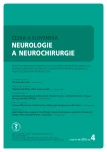Conus Medullaris Arteriovenous Malformation – a Case Report
Authors:
M. Smrčka 1; V. Juráň 1; O. Navrátil 1; J. Sedmík 2; A. Šprláková-Puková 2
Authors‘ workplace:
LF MU a FN Brno
Neurochirurgická klinika
1; LF MU a FN Brno
Radiodiagnostická klinika
2
Published in:
Cesk Slov Neurol N 2013; 76/109(4): 508-511
Category:
Case Report
Overview
Conus medullaris AVM is a very rare lesion. Only a few case reports have been described in the literature. The first cohort of 16 patients was described by Spetzler in April 2012. These AVMs are very complex, high‑flow lesions in eloquent area. The most frequent symptoms are paraparesis, sphincter disorders and pain. The lesion presents with bleeding in one third of patients. The authors describe a case of 30‑years old female with a half year history of slowly progressing symptoms. Her conus medullaris AVM was excised by microsurgery with a good result. This is the first case of a successfully treated conus medullaris AVM published in the Czech Republic. A literature review and our own experience suggest that the choice of treatment has to be individual. A combination of endovascular obliteration followed by microsurgical excision or microsurgical excision only is the most commonly used treatment modality. Good treatment results are possible in a large proportion of patients.
Key words:
arteriovenous malformation – conus medullaris – microsurgery – endovascular treatment
Sources
1. Wilson DA, Abla AA, Uschold TD, McDougall CG,Albuquerque FC, Spetzler RF. Multimodality treatment of conus medullaris arteriovenous malformations: 2 decades of experience with combined endovascular and microsurgical treatments. Neurosurgery 2012; 71(1): 100– 108.
2. Spetzler RF, Detwiler PW, Riina HA, Porter RW. Modified classification of spinal cord vascular lesions. J Neurosurg 2002; 96 (Suppl 2): 145– 156.
3. Carangelo B, Casasco AE, Vallone I, Peri G, Cerase A,Venturi C et al. Total occlusion of a conus medullaris pial arteriovenous malformation obtained with one session of superselective embolization. J Neurosurg Sci 2009; 53(3): 119– 123.
4. Tubbs RS, Mortazavi MM, Denardo AJ, Cohen-Gadol AA. Arteriovenous malformation of the conus supplied by the artery of Desproges- Gotteron. J Neurosurg Spine 2011; 14(4): 529– 531.
5. Hsu SW, Rodesch G, Luo CB, Chen YL, Alvarez H,Lasjaunias PL. Concomitant conus medullaris arteriovenous malformation and sacral dural arteriovenous fistula of the filum terminale. Interv Neuroradiol 2002; 8(1): 47– 53.
6. Misra BK, Purandare HR. Application of indocyanine green videoangiography in surgery for spinal vascular malformations. J Clin Neurosci 2012; 19(6): 892– 896.
7. Djindjian R. Spinal vascular malformations. J Neurosurgery 1976; 45(6): 727– 728.
Labels
Paediatric neurology Neurosurgery NeurologyArticle was published in
Czech and Slovak Neurology and Neurosurgery

2013 Issue 4
- Metamizole vs. Tramadol in Postoperative Analgesia
- Memantine in Dementia Therapy – Current Findings and Possible Future Applications
- Memantine Eases Daily Life for Patients and Caregivers
- Metamizole at a Glance and in Practice – Effective Non-Opioid Analgesic for All Ages
- Advances in the Treatment of Myasthenia Gravis on the Horizon
Most read in this issue
- Difficulties Diagnosing Progressive Multifocal Leukoencephalopathy in Patients Infected with the Human Immunodeficiency Virus – Case Reports
- Skull Base Surgery
- Neuropsychiatric View of Huntington‘s Disease
- Dysembryoplastic Neuroepithelial Tumor and its Atypical Variant in Children – Case Reports
